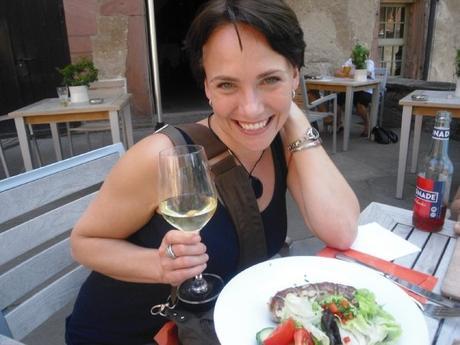
Marni Penning Coleman in Heidelberg, Germany, eating sausage.
Before Lisa Bryan, a certified health coach, food blogger and recipe developer from Los Angeles, was diagnosed with Celiac disease, she had traveled to all seven continents. But that stopped upon her diagnosis.
“That fear of the unknown was enough to keep my feet firmly planted for several years,” she says. “I was fearful of communicating my needs in foreign countries, I worried about cross-contamination and I wondered what I’d do if I got sick. So I played it safe and didn’t venture out for nearly four years, which, to a wanderluster, felt like an eternity!”
This is a common mindset among those with Celiac disease and gluten intolerance. It’s hard enough to go out to eat in your home country where you’re familiar with the cuisine, ingredients and speak the same language.
For someone who doesn’t have Celiac disease, the unknown factor when it comes to the cuisine is part of the fun of travel. But when eating anything containing gluten or has come in contact with gluten makes you so ill you can’t enjoy your trip for a period of time, that unknown is a big risk. The dishes and ingredients are foreign to you and you may not speak the language to effectively communicate your dietary restrictions. However, traveling with Celiac disease is quite possible.
“After several years I simply couldn’t sit still anymore,” Bryan says. “The explorer in me was craving some much needed and long overdue adventure. So one morning I said to myself, ‘I don’t know how I’m going to do this, but I’m going to figure it out.”
It can seem virtually impossible to eat gluten-free

Marni Penning Coleman at a pub in London.
For about 10 years illustrator Marni Penning Coleman struggled with stomach problems. She took Pepto-Bismol almost daily. Stomach cramps and long bouts in the bathroom were the norm. She thought she just had a sensitive stomach. It wasn’t until Coleman tried the Atkin’s diet when it was all the rage that she began to narrow in on what exactly it was that was triggering all of her stomach issues.
In order to follow the Atkin’s diet, Coleman had to knock out most gluten from her diet. However, she was still eating items with hidden gluten, like salad dressings, marinades, sauces, and oats not processed in a dedicated gluten-free facility.
“I could go out with friends for dinner and end up spending half the night in the restroom. I never knew exactly what would set me off,” says Coleman, a Washington D.C. illustrator. “I had a feeling that there were certain triggers that were the hot button for my intestinal distress, but I never realized it was a whole category of items.”
When Coleman was officially diagnosed with Celiac disease, she was confused – she had never heard of it before, plus, her diagnosis came in 2004, which was long before the gluten-free craze caught on.
“After a barrage of unpleasantness, which included four blood tests, lots of lab work, and a colonoscopy with biopsy of my small intestine, [a GI specialist] sat me down and said, ‘You have a disease. And if you never want to feel like this, you may never have wheat again as long as you live,’” Coleman recounts. “I thought, ‘She’s kidding, right?’ and I went out and had a beer, and immediately got sick. I finally realized that this was what my problem had been for the past 10 years or more.”
As Coleman began to eat completely gluten free, she found that she felt better than she ever had in her life.
“My weight regulated, I slept better, and it was a huge relief to be able to avoid what had been wrecking my insides for 10 years or more,” she says.
But being diagnosed with Celiac disease is only part of the battle.
“I have to be incredibly careful about what I eat and how it’s prepared…I just have to make sure that if I’m putting my health in another preparer’s hands, that they have to realize I’m not ‘going gluten free’ as a lifestyle choice. I have to make sure that whoever is preparing my food is well-versed in Celiac triggers,” Coleman explains.
Some of those triggers include that a person preparing food must wash their hands, change their gloves and use freshly washed bowls and utensils to ensure that no gluten cross-contamination occurs. When it comes to communal eating places like parties, picnics and salad bars, Coleman says it’s a nightmare.
“Utensils go from one tray of something I can’t have and [then] go into another tray of something I can have without me ever knowing until I get sick,” she says.
Melinda Arcara, a mom, author, gluten-free Health Coach and blogger from Chester Springs, PA, came to the same realizations as Coleman.
“Looking back, I had been sick my whole life with a wide range of symptoms. In my youth, I had throat infections all the time. In my teens I had G.I. problems and attention problems. In my 20s, I had recurrent bladder infections and weight fluctuations. In my 30s, I had joint pains, infertility, migraines, depression and anxiety…just to name a few of my symptoms,” she says. “I had been to a multitude of doctors that never [connected] my symptoms to food.”

Marni Penning Coleman showing off a restaurant’s offering of gluten-free fish and chips in Dublin.
When Arcara was diagnosed with gluten intolerance, she cried with joy.
“Not many people can say that, but I was so relieved to have a reason for feeling sick for so many years. I never dreamed that the wide array of symptoms I had been feeling over the years were from the food I was eating,” she says.
Being diagnosed with Celiac disease and gluten intolerance not only changed their views on food and the way they ate, but it also had an impact on another big aspect of both of their lives: travel.
Eating at restaurants in the U.S. is risky, let alone abroad when there may be a language barrier.
Celiac disease doesn’t have to limit where you go or where you stay
Freelance travel and lifestyle writer Paige Smith was diagnosed with Celiac disease and changed her diet right around the time she started traveling internationally on a long-term basis – she wasn’t going to let the diagnosis hold her back.
“I wouldn’t give up on the idea of visiting a particular country just because I’m concerned about the difficulty of finding gluten-free food there,” she says. “To me, it’s a struggle that’s worth it. Though experiencing different cuisines is such a fun part of traveling, I’d rather see a place—even if it means I have to eat pre-packed trail mix and bars the whole time––than not see it.”
But traveling with Celiac disease doesn’t mean you’re only limited to cooking for yourself and eating safe prepackaged snacks.
“Most high-quality restaurants will serve some type of vegetable dish or meat and fish dishes,” Smith says. “You can always inquire about the ingredients in a particular sauce if that’s the only deterrent, and most of the time chefs and cooks are more than happy to make you something slightly altered from the menu if you need it.”
“You can absolutely eat out. In fact, during my five months overseas, I ate out 80 percent of the time – from cafes and high-end restaurants, to farmer’s markets and yes, even street food in Thailand. It’s all doable,” Bryan says.
Some destinations make it easier for Celiacs
While you can really travel anywhere and use tips and pre-planning to avoid gluten, there are some destinations that tend to be friendlier toward those with Celiac disease, gluten intolerance or sensitivity.
“Mexico is very gluten-free friendly, simply because authentic Mexican food is mostly naturally gluten-free anyway – minus flour tortillas, of course,” Smith says.
“Greece, Mexico, and Ireland were absolutely amazing,” Coleman says. “From what I’ve read, Celiac disease seems to be most prevalent in Ireland and those of Irish descent (of which I am one). I even found a place in Dublin that had gluten-free fish & chips.”
In fact, Coleman found that most of Europe was pretty gluten-free savvy.
Norway is also gluten-free friendly.
“Everyone there knows exactly what celiac disease is, almost every restaurant has a gluten-free menu and gluten-free substitutions like pasta and pizza dough, and they make some of the freshest, softest gluten-free bread I’ve tasted anywhere in the world. I didn’t worry once when I was there,” Smith says.

Marni Penning Coleman found extensive a gluten-free section at Whiterose in London.
Plan ahead and ask questions
Before Bryan leaves for a trip, she looks at the prep work as part of the fun.
“I’ll research country specific ingredients and traditional meals. I’ll prepare wholesome food that travels well for my time in transit without packing a suitcase full of food. I’ll reserve a gluten-free meal on my flight as a back-up option. I’ll pack vitamins and essential supplements to ensure my health and digestion stay in top-notch form. I’ll order translation dining cards if visiting a foreign country,” Bryan explains.
As gluten-free diets become increasingly popular and knowledge of gluten intolerance spreads, it has given way for more and more restaurants to become Celiac-savvy.
When Coleman travels, she refers to the website Find Me Gluten Free to either find restaurants in advance or to find which ones nearby are gluten-free friendly.
“When traveling internationally, most restaurants have posted their menus outside, so I study them very, very carefully, and have my ‘I have a wheat/gluten allergy’ card ready to give to the waiter to ask the chef if the dish I’m ordering has any offending ingredients in it,” Coleman says. When she’s in a country where they speak a different language, she translates that card into the language before she goes and brings multiple copies.
But don’t just rely on your card – Coleman advises to be your own advocate, ask questions and talk to the chefs.
“Make sure that everything you’re ingesting is going to be safe for you. No one knows better than you do how your body reacts to gluten,” she says. “Don’t just trust that because a restaurant has a gluten-free menu listed that they know exactly what ingredients are truly gluten free.”
She suggests also bringing with you a list of the ingredients your body reacts to to share with the restaurant – this lets them know how important it is that your dish doesn’t contain or come into contact with any of those items.
“Don’t feel like you’re going to be a bother – no one wants to make you sick. They want you to enjoy their food and talk about it to others so they can get more business,” Coleman says. “If you enjoyed your meal and made it through unscathed, make sure you tell the restaurant that you had a great meal and how much it meant to you that they kept you safe. That way, the next time another a Celiac customer comes in, they’ll be excited to keep them safe, as well. Then tell all the rest of us where you ate so we can go there, too.”


